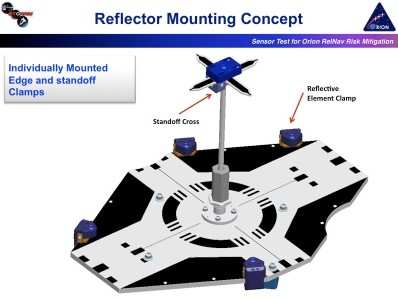New Docking Sensor Performs "Better Than Expected"
In an unprecedented on-orbit maneuver, Commander Mark Kelly
completed the first ever Orion Multi-Purpose Crew Vehicle
(MPCV)-like approach to the International Space Station at 0420 EDT
Monday as part of the Sensor Test for Orion Relative
Navigation Risk Mitigation (STORRM). The orbital rendezvous
verified the successful operation of the MPCV's next generation
docking sensor, which NASA has identified as a critical technology
needed for future space exploration missions.

The NASA, Lockheed Martin, and Ball Aerospace team worked
closely with STS-134 Mission Specialist Andrew Feustel to
successfully complete the on-orbit test of this system which will
make rendezvous and docking maneuvers safer for future spacecraft.
The flight test represented the first and only opportunity for
in-flight collaboration of NASA's three human spaceflight programs
... space shuttle, International Space Station and Orion
MPCV.
"This flight test demonstrated the exceptional capability of the
Vision Navigation Sensor (VNS) and the Docking Camera, two key
components of the Orion relative navigation system," said Catherine
Boone, Ph.D., the Lockheed Martin electro-optics engineer who was
working in NASA's Mission Control Center during the re-rendezvous
event. "We were able to collect about 600 gigabytes of data that
will verify the design meets the high performance standards
required for Orion MPCV and other future spacecraft. Follow-on
testing at our Space Operations Simulation Center in Denver will
also provide an opportunity to look at how we may be able to expand
on that performance to make the system as powerful and accurate as
possible for the dynamic environments of deep-space exploration
missions."

STORRM Sensors
Jeanette Domber, Ph.D., senior payloads system engineer and
Ball's lead for STORRM, explained that unlike other navigation
sensor flight experiments, which simply collected data during
normal shuttle operations, the STORRM flight test leveraged
America's human spaceflight assets in a true "test-like-you-fly"
scenario. "This test exercised the Orion relative navigation
sensors exactly as they will be flown on future human space
exploration vehicles," said Domber. "This mission provided NASA a
one-of-a-kind opportunity to prove out the performance of this
technology in a real spaceflight environment."
STORRM demonstrates a robust relative navigation design that
provides the required docking accuracy and range capability
necessary to meet crew safety, mass, volume and power requirements
for a wide variety of future NASA missions, including those into
deep space. The STORRM hardware components consist of a high
definition docking camera, the advanced laser-based VNS, an
avionics assembly to provide power and record data, a
space-certified laptop computer, and reflective docking targets
that were installed on the space station during STS-131.

Endeavour On Orbit File Photo
During the mission, STORRM's VNS performed better than expected
by providing continuous measurements from as far away as
three-and-a-half miles to within six feet of the space station --
three times the range capability of the current relative navigation
sensor. The next generation sensor technology also provided
exceptional three-dimensional images of the docking target.
As its nickname indicates, STORRM was a whirlwind project. When
given the opportunity to fly and test the system on one of the last
shuttle missions, the Orion STORRM team kicked into high-gear to
rapidly design, build and test all the components to be ready in
half the usual time required for such a system to be manifested for
the shuttle flight's payload.
"The Lockheed Martin, Ball and NASA STORRM team worked
efficiently and seamlessly to accomplish this important risk
mitigation test," said Larry Price, Lockheed Martin deputy program
manager for the Orion MPCV program. "It was an immense undertaking
and everyone gave it their all to design a system necessary for
future exploration spacecraft to conduct safe approach and docking
maneuvers to other spacecraft."

STORRM is an innovative technology development effort led by
NASA's Multi-Purpose Crew Vehicle Project Office at NASA Johnson
Space Center in partnership with NASA Langley Research Center,
Lockheed Martin Space Systems Company, and Ball Aerospace &
Technologies Corporation. This technology has earth-bound
applications for terrain mapping, robotics, military operations and
transportation, including collision avoidance systems for
vehicles.
 Classic Aero-TV: The Switchblade Flying Car FLIES!
Classic Aero-TV: The Switchblade Flying Car FLIES! ANN FAQ: Q&A 101
ANN FAQ: Q&A 101 ANN's Daily Aero-Term (04.12.24): Discrete Code
ANN's Daily Aero-Term (04.12.24): Discrete Code ANN's Daily Aero-Term (04.13.24): Beyond Visual Line Of Sight (BVLOS)
ANN's Daily Aero-Term (04.13.24): Beyond Visual Line Of Sight (BVLOS) ANN's Daily Aero-Linx (04.13.24)
ANN's Daily Aero-Linx (04.13.24)






